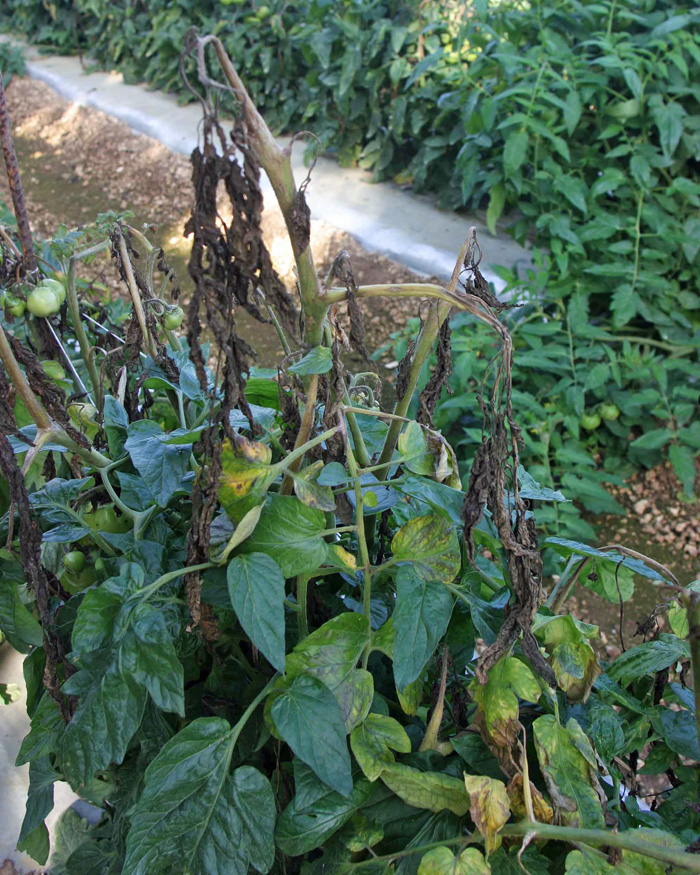By Joe Funderburk, North Florida REC, University of Florida, Quincy and Scott Adkins, USDA-ARS, Fort Pierce, FL
Tospoviruses are a group of plant infecting viruses that cause economically significant crop losses worldwide. Tomato spotted wilt virus (TSWV) is the original tospovirus discovered and it is well-known to cause vegetable, ornamental, and peanut disease epidemics in the southeastern U.S. including north Florida.
Figure 1. Tomato chlorotic spot virus symptoms on a young tomato plant.
In recent years, several relatives of TSWV have been detected in south Florida. Groundnut ringspot virus (GRSV) was first detected in tomato in late 2009 and subsequently in pepper, tomatillo and eggplant. In 2012, Tomato chlorotic spot virus (TCSV) was also detected in tomato (Figures 1 and 2) and subsequently in pepper. At the present time, TSWV, GRSV and TCSV are all established in Florida and may be found in all major solanaceous (tomato, pepper, eggplant, etc.) vegetable crops. GRSV has also been detected in solanaceous weeds including American black nightshade and cutleaf groundcherry. TCSV has recently been detected in ornamental crops including annual vinca (also known as periwinkle), Hoya (Hoya wayetii, commonly known as waxflower) and false Christmas cactus (Schlumbergera truncata). Identification of these weed and ornamental species as GRSV or TCSV hosts demonstrates continuing host expansion for these emerging tospoviruses in Florida, and has implications for management, since vegetable and ornamental crops may share production space.

Figure 2. Tomato chlorotic spot virus-induced terminal stem and leaf death in tomato.
All tospoviruses are transmitted by one or more species of thrips (tiny, flying insects). Western flower thrips (Frankliniella occidentalis) is a major vector of TSWV worldwide and also in Florida. Western flower thrips has also been demonstrated to be a vector (or transmitter) of GRSV and TCSV in Florida. Other thrips species may have more significant roles in transmission in certain geographic areas or crops. Tobacco thrips (F. fusca) is a major TSWV vector in peanuts and also in north Florida. Common blossom thrips (F. schultzei) have been demonstrated to be a vector of GRSV in Florida. Further study is needed to determine if any additional thrips species may also be vectors for GRSV and/or TCSV in Florida. Vegetable fields in Florida are commonly inhabited by additional thrips species including melon thrips (Thrips palmi), eastern flower thrips (F. tritici) and Florida flower thrips (F. bispinosa); so, understanding the role of each species in vectoring these viruses in the field is important.
In all known cases, thrips must acquire the tospovirus when they are larvae to be able to transmit when they become adults. This virus-vector relationship makes management difficult, as control of virus-laden adults with insecticides is not effective in preventing them from transmitting the virus to plants. Management tactics that are effective in preventing spread of the virus by adult thrips include: ultraviolet-reflective barriers and mulches, systemic acquired resistance inducers (substances that stimulate a plant’s natural “immune system”), conservation of natural enemies, and optimal soil fertility. Additional spread of the virus can occur when larvae feed and develop on infected plants within the field. Careful monitoring and control of the larvae with insecticides is effective in reducing additional spread.
Commercially available TSWV-resistant tomato cultivars have been demonstrated to also offer resistance to Florida isolates of GRSV and TCSV. These include plum, large round determinate, large round indeterminate, large round heritage, and large round grape types. It is very important to use an integrated pest management approach when managing tospoviruses. The thrips vectors develop resistance rapidly to insecticides and the tospoviruses also develop strains able to produce disease symptoms in the resistant tomato cultivars.
Neither GRSV nor TCSV have been found in northern Florida or in peanut in Florida. A number of tactics are used to manage TSWV in peanut, including the use of resistant cultivars. Whether TSWV-resistant peanut cultivars also have resistance to GRSV or TCSV has not been determined.